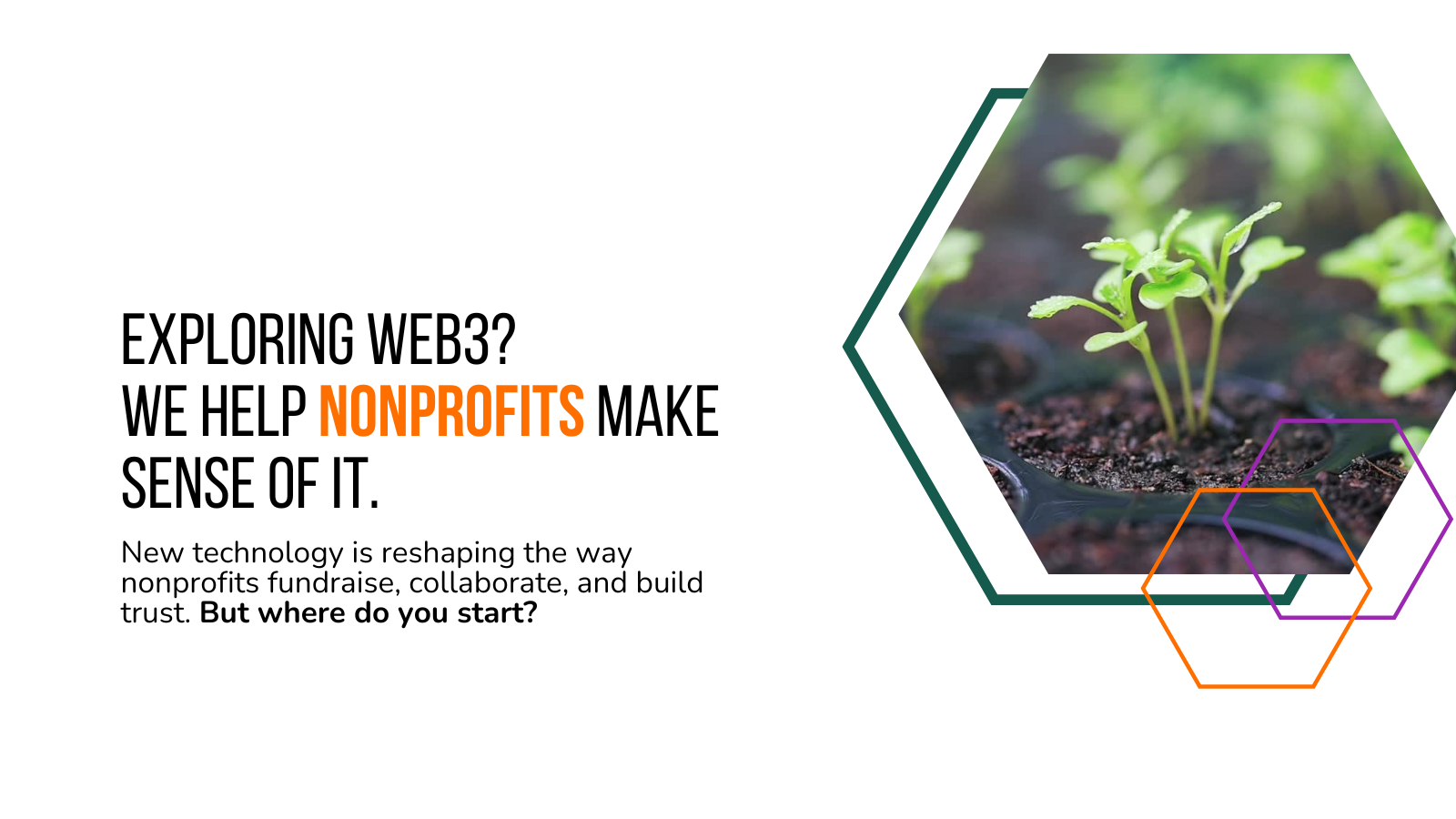
As emerging technologies continue to reshape the nonprofit landscape, many organizations are exploring how Web3 (the umbrella term for blockchain, cryptocurrencies, and other decentralized technologies) can help future-proof their missions. From engaging younger donors to creating new revenue streams, Web3 presents powerful opportunities to enhance transparency, trust, and community engagement.
But alongside the promise comes a unique set of risks.
Web3 is still evolving, and with it comes complex security, compliance, and operational challenges. That’s why it’s critical for nonprofits to approach this space with caution and strategy. In this article, we share 10 essential Web3 safety tips to help nonprofits explore the decentralized web securely and confidently.
It is important to note that this list is not exhaustive and does not constitute legal or financial advice. Always consult with security, legal, and compliance professionals when engaging with blockchain or cryptocurrency platforms.
If you find yourself feeling overwhelmed as you work your way through this list, you’re not alone, and you don’t have to navigate Web3 alone either. At Crypto Altruists, we offer bespoke consulting services to help nonprofits confidently explore crypto, blockchain, and decentralized tools. Whether you’re just getting started or ready to scale your impact, we’re here to help.
Let’s start with the most obvious one – never, and I mean NEVER, share your private keys with anyone. In the world of Web3, your private keys are akin to the keys to your safe. They are the ultimate access to your digital assets and must be guarded zealously. Never share these keys with anyone, regardless of the circumstances. Educate your team about the importance of private key security, and ensure you have sound policies in place for managing your private keys safely. Loss or theft of private keys can lead to the irretrievable loss of assets, a risk no nonprofit can afford to take.
Before building your own infrastructure, partner with trusted platforms like Endaoment, Giveth, The Giving Block, Givepact, or Crypto for Charity. These services offer secure, nonprofit-friendly tools for accepting crypto donations and managing compliance. This approach can also help connect you with a network of other nonprofits and donors in the space, making it easier to grow your presence in Web3. Such partnerships can provide a smoother transition into Web3, helping you learn the ropes without the risks of going it alone.
It’s a common saying that in Web3, it’s all about “collaboration over competition”. Partnering with reputable Web3 projects can help accelerate your mission, but it's vital to exercise due diligence before agreeing to any partnerships. Here are some key questions you can ask:
These are all questions you should be asking as you determine whether to partner with a crypto project.
As with any new venture, entering Web3 requires well-defined policies and procedures to guide your organization’s activities. Some basic policies that you may want to consider implementing include, but are not limited to:
It’s important that you consult with your Board, as well as your financial, legal, and I.T. departments, to develop a robust range of policies. It’s equally important to regularly update and review these policies to identify vulnerabilities or gaps, and to ensure they keep pace with the rapidly changing Web3 environment and any new threats that may emerge. Clear guidelines will not only protect your organization but will also instill confidence in your donors and stakeholders.
In the initial stages of accepting cryptocurrency donations and engaging with the Web3 community, it will be important to carefully consider how you would like to store and secure your digital assets. If, like many nonprofits, you decide to instantly convert your crypto donations to fiat via a third-party platform, and don’t wish to hold any digital assets, then this isn’t as important for you.
However, if you are planning to hold digital assets, there are many considerations to navigate with your team. First, you will need to decide whether to hold your funds on an exchange, hot wallet, or cold wallet. More information on each can be found here. While cold wallets, also known as hardware wallets, come with many security benefits and give you true control over your funds, some nonprofits may worry about securing their own private keys, so it is really up to the preference and comfort level of each organization. Second, you will want to decide who has access to your assets and ensure strict control procedures are in place to limit access. You will also want to conduct regular audits of your portfolio of assets, ensuring there are no discrepancies or suspicious transactions. It is also advisable to consider implementing a multi-signature wallet, which we will highlight next.
Utilize multi-signature wallets for your Nonprofit’s transactions to ensure no single individual has full control over your funds. These wallets require multiple approvals from different team members before transactions can be executed, adding an extra layer of security. This approach minimizes the risks of unauthorized transactions, decentralizes power away from one individual, and ensures a higher level of scrutiny over every transaction.
For a deeper dive into multi-signature wallets, check out this article from Ledger Academy.
It only takes one small mistake from a member of your team to result in a loss of funds or trust. As such, it’s important to invest time in educating your team about the potential risks and best practices of operating in this space. This can include training on:
An informed team is your first line of defense against security threats.
Smart contracts are a cornerstone of Web3, automating transactions and agreements. However, they are not immune to risks. Ensure that any smart contract you engage with is thoroughly vetted for security vulnerabilities. One way to do this is to determine if the smart contracts have been audited by a reputable organization like Certik or Fairyproof, and if the project has addressed any concerns that were raised during the audits. For nonprofits who are new to Web3, assessing smart contract risks can be daunting, so it can be helpful to engage expert advice to analyze and monitor the smart contracts you depend on.
Furthermore, if you are regularly engaging with smart contracts, it is good “smart contract hygiene” to regularly review the smart contracts you have granted permission to, and revoke permissions on a regular basis. A great tool for this is Revoke, which allows you to simply input your wallet address, see the smart contracts you have granted permissions to and funds at risk, and revoke the permissions. This helps you reduce attack surfaces by removing unnecessary contract permissions tied to your wallet.
The regulatory landscape for Web3 is still in its infancy and can change rapidly. The regulations in place also vary drastically by jurisdiction, which can add confusion. It’s important to stay informed about the latest regulatory developments and compliance requirements and engage your legal consultants as necessary. This is crucial for maintaining the legal integrity of your operations and avoiding inadvertent legal pitfalls
It’s important to stay current on:
It can be helpful to subscribe to compliance updates, attend webinars, and engage legal counsel to ensure you're operating safely and legally.
Lastly, it can be extremely valuable to foster a community in Web3 centered around trust and transparency. Engage with other nonprofits and entities in the Web3 space to share insights, experiences, and best practices, attend community events and conferences, and continuously build your network with reputable Web3 projects and leaders. A strong community can provide support, advice, and warnings about emerging threats, making it an invaluable resource.
It can also be valuable to connect with Web3-focused security companies, such as Boring Security, to help educate you on Web3 safety and security, and to consult with you on best practices to remain safe in the space.
Web3 opens up a world of possibility for nonprofits, from transparent giving and decentralized governance to new forms of community fundraising. But like any frontier, it comes with challenges that require preparation, education, and caution.
Start small, work with trusted partners, build strong internal protocols, and never stop learning.
We help nonprofits cut through the noise and explore practical ways to use tools like crypto donations, transparent funding, and decentralized collaboration. Whether you're just getting started or ready to take the next step, our workshops and advisory services can help you move forward with clarity and confidence.👉 Learn more about our consulting services

Support thoughtful, independent crypto journalism and help us continue highlighting blockchain’s potential for social and environmental impact.
cryptoaltruists.eth